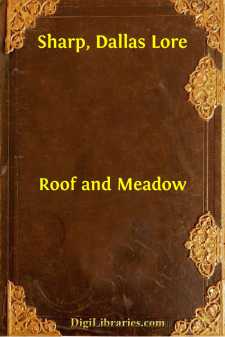Categories
- Antiques & Collectibles 13
- Architecture 36
- Art 48
- Bibles 22
- Biography & Autobiography 813
- Body, Mind & Spirit 141
- Business & Economics 28
- Children's Books 12
- Children's Fiction 9
- Computers 4
- Cooking 94
- Crafts & Hobbies 4
- Drama 346
- Education 46
- Family & Relationships 57
- Fiction 11826
- Games 19
- Gardening 17
- Health & Fitness 34
- History 1377
- House & Home 1
- Humor 147
- Juvenile Fiction 1873
- Juvenile Nonfiction 202
- Language Arts & Disciplines 88
- Law 16
- Literary Collections 686
- Literary Criticism 179
- Mathematics 13
- Medical 41
- Music 40
- Nature 179
- Non-Classifiable 1768
- Performing Arts 7
- Periodicals 1453
- Philosophy 64
- Photography 2
- Poetry 896
- Political Science 203
- Psychology 42
- Reference 154
- Religion 513
- Science 126
- Self-Help 83
- Social Science 81
- Sports & Recreation 34
- Study Aids 3
- Technology & Engineering 59
- Transportation 23
- Travel 463
- True Crime 29
Roof and Meadow
Categories:
Description:
Excerpt
BIRDS FROM A CITY ROOF
I laid down my book and listened. It was only the choking gurgle of a broken rain-pipe outside: then it was the ripple and swish of a meadow stream. To make out the voices of redwings and marsh-wrens in the rasping notes of the city sparrows behind the shutter required much more imagination. But I did it. I wanted to hear, and the splash of the water helped me.
The sounds of wind and water are the same everywhere. Here at the heart of the city I can forget the tarry pebbles and painted tin whenever my rain-pipes are flooded. I can never be wholly shut away from the open country and the trees so long as the winds draw hard down the alley past my window.
But I have more than a window and a broken rain-pipe. Along with my five flights goes a piece of roof, flat, with a wooden floor, a fence, and a million acres of sky. I couldn't possibly use another acre of sky, except along the eastern horizon, where the top floors of some twelve-story buildings intercept the dawn.
With such a roof and such a sky, when I must, I can, with effort, get well out of the city. I have never fished nor botanized here, but I have been a-birding many times.
Stone walls do not a prison make,nor city streets a cage—if one have a roof.
A roof is not an ideal spot for bird study. I would hardly, out of preference, have chosen this with its soot and its battlement of gaseous chimney-pots, even though it is a university roof with the great gilded dome of a state house shining down upon it. One whose feet have always been in the soil does not take kindly to tar and tin. But anything open to the sky is open to some of the birds, for the paths of many of the migrants lie close along the clouds.
Other birds than the passing migrants, however, sometimes come within range of my look-out. The year around there are English sparrows and pigeons; and all through the summer scarcely an evening passes when a few chimney-swallows are not in sight.
With the infinite number and variety of chimneys hedging me in, I naturally expected to find the sky alive with swallows. Indeed, I thought that some of the twenty-six pots at the corners of my roof would be inhabited by the birds. Not so. While I can nearly always find a pair of swallows in the air, they are surprisingly scarce, and, so far as I know, they rarely build in the heart of the city. There are more canaries in my block than chimney-swallows in all my sky.
The swallows are not urban birds. The gas, the smoke, the shrieking ventilators, and the ceaseless sullen roar of the city are hardly to their liking. Perhaps the flies and gnats which they feed upon cannot live in the air above the roofs. The swallows want a sleepy old town with big thunderful chimneys, where there are wide fields and a patch of quiet water.
Much more numerous than the swallows are the night-hawks. My roof, in fact, is the best place I have ever found to study their feeding habits. These that flit through my smoky dusk may not make city nests, though the finding of such nests would not surprise me. Of course a night-hawk's nest, here or anywhere else, would surprise me; for like her cousin, the whippoorwill, she never builds a nest, but stops in the grass, the gravel, the leaves, or on a bare rock, deposits her eggs without even scratching aside the sticks and stones that may share the bed, and in three days is brooding them—brooding the stones too....



